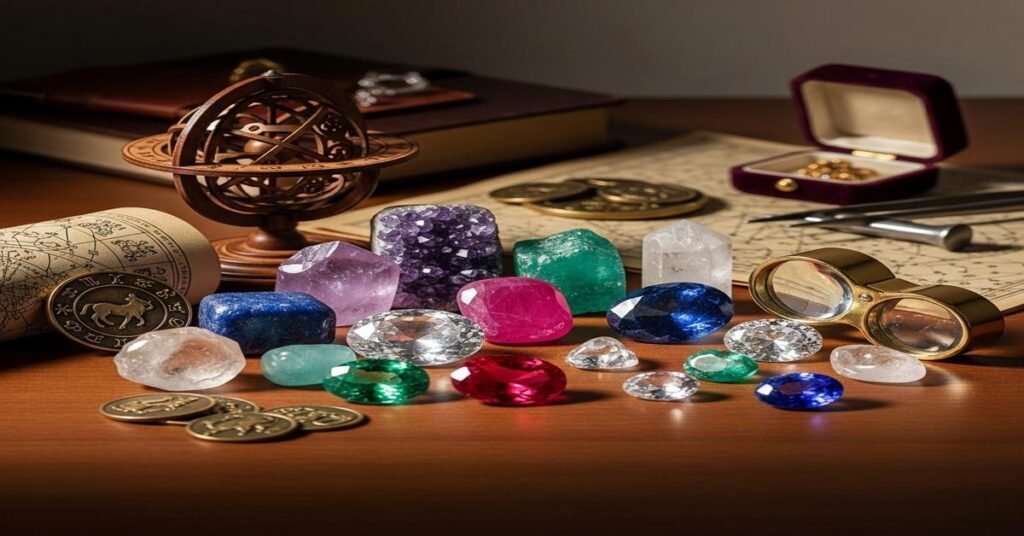People buy gems for reasons that mix beauty, culture and personal belief. Astrology adds a layer of meaning for many buyers. That can be fine. But myths about stones, metals and “planetary powers” can lead to poor purchases. Below are seven common myths jewelers hear. For each, I explain why it’s misleading and give clear, practical advice so you can buy smarter.
Myth 1 — “Your zodiac stone will change your luck”
Many sellers present a specific gem as a quick fix for life changes. The truth: no gemstone has scientifically proven effects on luck, health or personality. Wearing a stone can change how you feel about yourself. That can change behavior. But the gem itself does not alter external events.
Why it matters: when buyers expect life-changing results, they may overspend or ignore practical factors like durability and fit. Choose a birthstone for meaning and durability. For example, a September sapphire (corundum, Mohs 9) is good for daily wear. An opal (Mohs 5.5–6.5) makes a nicer occasional piece.
Myth 2 — “Bigger carat always means better”
Carat measures weight, not beauty. A 1.00 ct round diamond is about 6.4 mm across. A well-cut 0.90 ct can look larger than a poorly cut 1.20 ct. Cut affects sparkle more than carat.
Why it matters: price jumps sharply with carat, especially at round-brilliant benchmarks (0.50 ct, 1.00 ct, 2.00 ct). Instead of chasing size, balance carat with cut, clarity and color. A 0.95 ct excellent-cut diamond can outperform a 1.20 ct poor-cut diamond in appearance and may cost less.
Myth 3 — “Natural gems are always better than lab-grown”
Natural gems formed in the earth. Lab-grown gems formed in a lab. Chemically and optically, many lab-grown stones are identical to natural ones. For example, CVD or HPHT lab-grown diamonds are carbon crystals with the same hardness and brilliance as mined diamonds.
Why it matters: value differs. Lab-grown diamonds typically cost 30–40% less than comparable mined diamonds. For colored gems, a lab-grown sapphire or emerald can be flawless and more affordable. Decide whether you pay a premium for natural origin or prefer value and performance.
Myth 4 — “If a stone is treated, it’s worthless”
Treatments are common and can improve appearance. Heat treatment on sapphires and rubies is standard and stable. Emeralds are often oiled or resin-filled to improve clarity. Lead-glass filling in rubies increases apparent clarity but requires more care.
Why it matters: treatments affect value and care but don’t always ruin a gem. Honest disclosure matters. Ask for specifics: heated? oiled? fracture-filled? For high-value stones, request a lab report (SSEF, GRS, or equivalent) that states treatment type. A heat-treated 2.0 ct sapphire can be an excellent buy. A lead-glass-filled ruby is more fragile and should be treated as a fragile piece.
Myth 5 — “Hardness = indestructible”
Hardness (Mohs scale) measures scratch resistance. Diamonds are 10, corundum (sapphire/ruby) 9, topaz 8, quartz 7, and opal 5.5–6.5. Toughness measures resistance to breaking and chipping. These are different.
Why it matters: opals and pearls can scratch and chip even though they may look durable. A 14k rose gold ring with a 6 mm opal requires a protective setting and occasional care. For everyday rings, choose hardy stones: diamond, sapphire or ruby. If you like softer gems, plan for occasional removal and safe storage.
Myth 6 — “All gold is the same — color equals purity”
Gold’s purity is measured in karats: 24k = 100% gold, 18k = 75% (750), 14k = 58.3% (585), 9k = 37.5% (375). Color comes from alloy metals. Rose gold has copper; white gold is a yellow gold alloy that’s rhodium-plated for bright white finish.
Why it matters: high-karat gold (22k / 91.7%) is softer and dents more easily. For rings worn daily, 14k or 18k is more practical. If astrology requires “pure” gold, discuss why with the seller and choose a karat that balances the belief with wearability. Also check marks: look for stamped hallmarks like “14k” or “750” and ask about rhodium plating that may wear off over time.
Myth 7 — “Certification isn’t necessary if the seller seems trustworthy”
Good relationships matter, but documentation protects you. A diamond without a lab report can’t be independently verified for color, clarity or treatments. Lab reports (GIA, AGS, IGI) describe cut, color, clarity, polish, symmetry and any treatments. For colored gems, request a report from a respected lab that notes origin and treatment.
Why it matters: a 1.5 ct sapphire with diffusion treatment should be priced differently than a natural, untreated 1.5 ct. A GIA report for a 1.00 ct diamond provides the exact measurements (for example, 6.45 x 6.40 x 3.90 mm) and cut grade, which helps when insuring or reselling.
Practical checklist before you buy
- Ask for full disclosure: treatments, origin, karat, plating, and care instructions.
- Get a report: diamonds—GIA/AGS; colored gems—SSEF, GRS or comparable lab for high-value stones.
- Match the gem to use: daily ring (sapphire/diamond), occasional pendant (opal, pearl).
- Consider alloys: 14k for durability, 18k for richer color but softer metal; platinum 950 for heavy wear and hypoallergenic needs.
- Set expectations: know whether you prioritize origin, aesthetics or value. They’re not always the same.
Belief and beauty are valid reasons to buy jewelry. But clarity about treatments, materials and practical limits keeps purchases satisfying. Ask direct questions, request documentation, and focus on what will work for how you actually wear the piece.
I am G S Sachin, a gemologist with a Diploma in Polished Diamond Grading from KGK Academy, Jaipur. I love writing about jewelry, gems, and diamonds, and I share simple, honest reviews and easy buying tips on JewellersReviews.com to help you choose pieces you’ll love with confidence.

